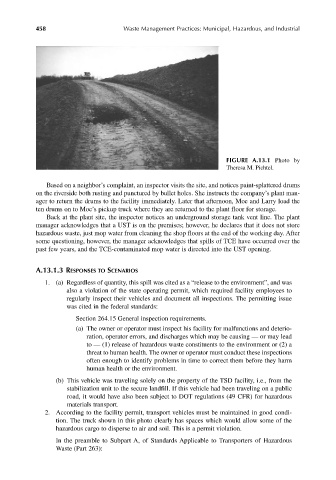Page 487 - Materials Chemistry, Second Edition
P. 487
CAT3525_C13.qxd 1/27/2005 12:30 PM Page 458
458 Waste Management Practices: Municipal, Hazardous, and Industrial
FIGURE A.13.1 Photo by
Theresa M. Pichtel.
Based on a neighbor’s complaint, an inspector visits the site, and notices paint-splattered drums
on the riverside both rusting and punctured by bullet holes. She instructs the company’s plant man-
ager to return the drums to the facility immediately. Later that afternoon, Moe and Larry load the
ten drums on to Moe’s pickup truck where they are returned to the plant floor for storage.
Back at the plant site, the inspector notices an underground storage tank vent line. The plant
manager acknowledges that a UST is on the premises; however, he declares that it does not store
hazardous waste, just mop water from cleaning the shop floors at the end of the working day. After
some questioning, however, the manager acknowledges that spills of TCE have occurred over the
past few years, and the TCE-contaminated mop water is directed into the UST opening.
A.13.1.3 RESPONSES TO SCENARIOS
1. (a) Regardless of quantity, this spill was cited as a “release to the environment”, and was
also a violation of the state operating permit, which required facility employees to
regularly inspect their vehicles and document all inspections. The permitting issue
was cited in the federal standards:
Section 264.15 General inspection requirements.
(a) The owner or operator must inspect his facility for malfunctions and deterio-
ration, operator errors, and discharges which may be causing — or may lead
to — (1) release of hazardous waste constituents to the environment or (2) a
threat to human health. The owner or operator must conduct these inspections
often enough to identify problems in time to correct them before they harm
human health or the environment.
(b) This vehicle was traveling solely on the property of the TSD facility, i.e., from the
stabilization unit to the secure landfill. If this vehicle had been traveling on a public
road, it would have also been subject to DOT regulations (49 CFR) for hazardous
materials transport.
2. According to the facility permit, transport vehicles must be maintained in good condi-
tion. The truck shown in this photo clearly has spaces which would allow some of the
hazardous cargo to disperse to air and soil. This is a permit violation.
In the preamble to Subpart A, of Standards Applicable to Transporters of Hazardous
Waste (Part 263):

